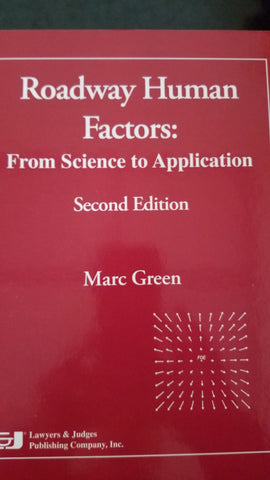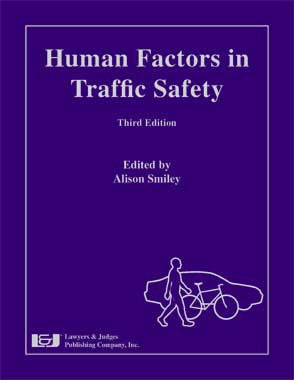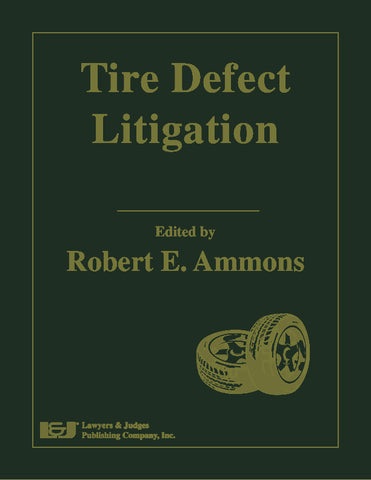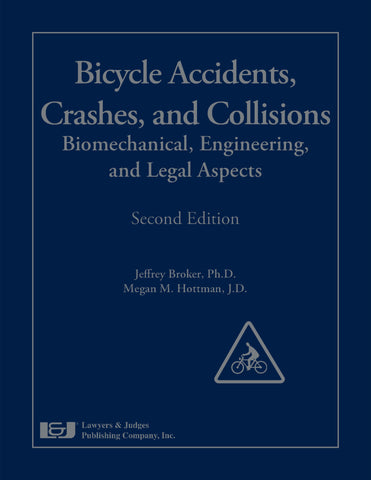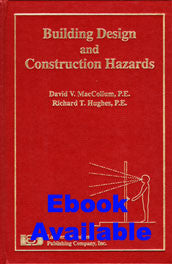
Building Design and Construction Hazards, First Edition
- Author: David V. MacCollum, Richard T. Hughes
- ISBN 10: 0-913875-31-7
- ISBN 13: 978-0-913875-31-5
- Copyright Date Ed: May 15, 2005
- Pages: 599 pages
- Binding Information: Casebound
- Size: 6 ✕ 9 Inches (US)
The role of the engineer either as a designer or construction manager generally provides the best opportunity to identify the hazards that cause injury or damage. Part of this task includes ensuring for design features and modifications that will minimize hazardous conditions during construction and life of the structure. Identifying the hazards that most commonly endanger the users during the life cycle of the building facility is the primary objective of this book. This objective is accomplished by instructing the engineer how to sidestep these hazards at the time of design and construction. This book delves into the cause of many hazards common to construction, including fire, maintenance, mold, structural failure, and operational conditions and details ways to minimize or avoid these conditions, reducing the possibility of injury and damage.
Comprehensively organized from the “ground up”, this book covers all phases of any major building project. Part One addresses the concepts of hazard, liability, and ways system safety engineering works to overcome human error. Part Two covers possible hazards encountered in both interior and exterior construction plans and offers ways to eliminate them before any construction begins. Part Three covers safe construction techniques to minimize unavoidable hazards, while Part Four extends into the post-construction life of the building and outlines optimal safe practices for the user/occupant.
Topics Include
- Ground Rules
- System Safety Engineering
- Regulatory Agencies
- Design Basics
- Construction Management
- Public Relations
- Electricity, Appliances, Dryers, Heating Elements, Circuits
- Fences, Banisters, Balconies, and Handrails
- Falling Objects
- Fire Protection
- Sidewalks, Parking Lots and Parking Garages
- Stairs, Steps, Ledges, Staircase and Single Steps
- Ramps
- Doors, Windows and Glass
- Chairs and Furniture
- Ceiling Heights, Signs, Protruding Objects and Head Clearance
- Lighting and Emergency Lighting
- Elevators, Automatic Doors, Revolving Doors and Escalators
- Maintenance-Snow, Ice, Grease, Oil and Floor Cleaning
- Ice Guards and Roof Drains and Site Drainage
- Stadiums and Bleachers
- Street Grates and Parking Curbs, Single Steps
- Playgrounds and Swimming Pools
- Gases
- Mold
Table of Contents
Part I, Ground Rules
Chapter 1: Nature of Hazards Theory of Hazard Prevention
1.1 Introduction
1.2 Hazard Definition
1.3 Types of Hazards
1.4 Management Dysfunctions that Accommodate Hazards
1.5 Hazards and the Law
Chapter 2: System Safety Engineering
2.1 Introduction
2.2 Illustration of a Systems Approach
2.3 Environmental Concerns
2.4 Mathematical Analyses of System Safety
2.5 Reliability and Fault Tree Sequence
2.6 System Safety Standards
2.7 The Future of Safety
Chapter 3: Premise Liability
3.1 Introduction
3.2 Code References
Chapter 4: Regulatory Agencies
4.1 Introduction
4.2 Engineer Responsibilities
4.3 Code References
Chapter 5: Human Characteristics
5.1 Introduction
5.2 Technical Data on People
5.4 Noise
5.5 Dust
Part Two: Design Basic
Section A, Interior
Chapter 6: Means of Egress
6.1 Introduction
6.2 Slips and Falls on Floor Surfaces
6.3 Trips and Falls
Chapter 7: Stairs, Steps, Ledges and Staircases
7.1 Introduction
7.2 Single Steps
7.3 Case in Point
7.3 Code References and Industry Standards
Chapter 8: Ramps
8.1 Introduction
8.2 Case in Point
8.3 Code References and Industry Standards
Chapter 9: Doors, Windows and Glass
9.1 Introduction
9.2 Allowable Glazing Materials
9.3 Case in Point
9.4 Code References and Industry Standards
Chapter 10: Chairs and Furniture
10.1 Chairs and Furniture
10.2 Bathrooms, Showers and Vanities
Chapter 11: Ceiling Heights, Signs, Protruding Objects and Head Clearance Awnings
11.1 Introduction
11.2 Case in Point
11.3 Code References and Industry Standards
Chapter 12: Electricity, Appliances, Kerosene Heaters, Heating Elements and Circuits
12.1 Introduction
12.2 Electric-Arc Welding
Chapter 13: Fences, Banisters, Balconies and Handrails
13.1 Introduction
13.2 Case in Point
13.3 Code References and Industry Standards
Chapter 14: Lighting and Emergency Lighting
14.1 Introduction
14.2 Case in Point
14.3 Code References and Industry Standards
Chapter 15: Sight Distance, Size, Contrast, Color and Light
15.1 Introduction
15.2 Examples
15.3 Code References and Industry Standards
Chapter 16: Elevators, Automatic Doors, Revolving Doors, Escalators and Conveyors
16.1 Introduction
16.2 Conveyors
16.3 Examples
Chapter 17: Falling Objects
17.1 Introduction
17.2 Cases in Point
17.3 Chance of Injury or Death
17.4 History
17.5 Code References and Industry Standards
17.6 Patents
17.7 Representative Litigation
Chapter 18: Gases
18.1 Carbon Monoxide
18.2 Carbon Monoxide Poisoning
18.3 What are the Chances of Injury or Death?
18.4 Carbon Monoxide Poisoning Continues to Occur
18.5 How Carbon Monoxide can be Controlled?
18.6 History
18.7 Code References and Industry Standards
18.8 Representative Litigation
Chapter 19: Mold
19.1 Introduction
19.2 Code References
Chapter 20: Fires, Fire Safety, Explosions and Smoke Detectors
20.1 Introduction
20.2 Fire Prevention
20.3 Fire Protection System Hazards
20.4 History
20.5 Code References and Industry Standards
20.6 Representative Litigation
Section B, Exterior
Chapter 21: Sidewalks, Parking Lots and Parking Garages
21.1 Introduction
21.2 Case in Point
21.3 Code References and Industry Standards
Chapter 22: Maintenance–Snow, Ice, Grease, Oil and Floor Cleaning
22.1 Introduction
22.2 Case in Point
22.3 Code References
Chapter 23: Ice Guards and Roof Drains, and Site Drainage
23.1 Introduction
23.2 Case in Point
23.3 Code References
Chapter 24: Stadiums, Grandstands and Bleachers
24.1 Introduction
24.2 Case in Point
24.3 Code References and Industry Standards
Chapter 25: Street Grates, Open Grid Floors and Joints in Walking Surfaces
25.1 Introduction
25.2 Case in Point
25.3 Code References and Industry Standards
Chapter 26: Playgrounds and Swimming Pools
26.1 Playgrounds
26.2 Swimming Pools
26.3 Case in Point
26.4 Code References and Industry Standards
Part Three: Construction
Chapter 27: Construction In Occupied Buildings
27.1 Construction Management
27.2 Unsafe Equipment Control Systems
Chapter 28: Mobile Equipment
28.1 Large Truck Hazards
28.2 Forklift
28.3 Blind Zones on Moving Equipment
28.4 Unsafe Equipment Control Systems
Chapter 29: Construction Methods
29.1 Wood Frame Construction
29.2 Concrete Formwork
29.3 Steel Erection
29.4 Masonry Failure Hazards
Chapter 30: Ladders, Scaffoldings and Platforms
30.1 Introduction
30.2 Ladders
30.3 Scaffolding
30.4 Access and Work Platforms
30.5 Fall Prevention vs. Fall Protection
30.6 How to Ensure Safe Access and Working Locations
Chapter 31: Confined Spaces, Manholes, Tanks and Attics
31.1 Introduction
31.2 Confined Spaces
31.3 Trenching
31.4 Hazard Isolation
Chapter 32: Cranes, Hoist, Blocking and Rigging
32.1 Crane Upsets
32.2 Equipment Powerline Contact
32.3 Killer Hooks
32.4 Crane Two-Blocking Hazard
Part Four: The User/Occupant
Chapter 33: Moving Parts of Machinery
33.1 Introduction
33.2 Case In Point
33.3 What are the Chances of Injury or Death?
33.4 How Injury Can be Prevented
33.5 Types of Machine Guards
33.6 History
33.7 Code References and Industry Standards
33.8 Patents
33.9 Representative Litigation
33.10 Lessons Learned
Chapter 34: Operational Manuals and User Training

